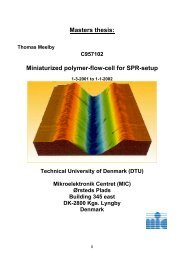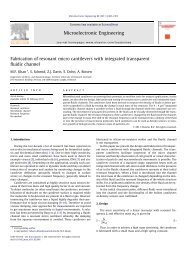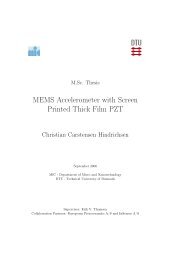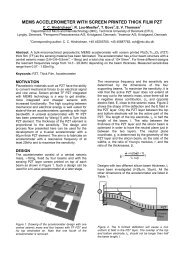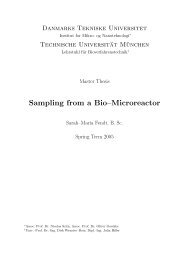Prototyping of microfluidic systems with integrated ... - DTU Nanotech
Prototyping of microfluidic systems with integrated ... - DTU Nanotech
Prototyping of microfluidic systems with integrated ... - DTU Nanotech
Create successful ePaper yourself
Turn your PDF publications into a flip-book with our unique Google optimized e-Paper software.
2.2 Fluidics and micr<strong>of</strong>luidics 11<br />
2.2.1 Mixing in micr<strong>of</strong>luidics<br />
Controlling the behaviour <strong>of</strong> the fluid in micr<strong>of</strong>luidic <strong>systems</strong> includes<br />
controlling mixing <strong>of</strong> different parts <strong>of</strong> the fluid. If the mixing <strong>of</strong> a given<br />
system is not understood or well controlled, concentration measurements<br />
might be erroneous, or separation <strong>of</strong> e.g. particles in a flow might not<br />
work as expected.<br />
As shown above, micr<strong>of</strong>luidics have low Reynolds numbers, so that<br />
turbulence in the system is excluded. The absence <strong>of</strong> turbulence, like<br />
when e.g. a cocktail is shaken, makes mixing in the system difficult,<br />
since the fluctuations in the fluid particle velocities, which are needed<br />
for turbulent mixing, are largely missing.<br />
As shown in Fig. 1.1, diffusion alone will only be sufficient for <strong>systems</strong><br />
<strong>with</strong> dimensions below a certain scale, typically some 10-100 µm, if a<br />
complete mixing <strong>of</strong> the liquid is to take place <strong>with</strong>in a reasonable time<br />
frame, that is in the order <strong>of</strong> seconds. For larger <strong>systems</strong>, <strong>with</strong> channel<br />
widths <strong>of</strong> e.g. one millimeter, diffusion time rises to many minutes,<br />
which would be too long for many point-<strong>of</strong>-care <strong>systems</strong>, and longer<br />
than when using existing, macroscopic methods.<br />
In order to mix a system efficiently, the different parts <strong>of</strong> the fluid<br />
must be rearranged. If turbulence is not achievable, as in the case <strong>of</strong><br />
micr<strong>of</strong>luidics, the fluid parts can be moved by methods like chaotic<br />
advection [6], where a liquid is mixed by repeatedly laminating and<br />
folding layers <strong>of</strong> e.g. high and low concentration. In this manner, the<br />
diffusion distance is radically reduced to the order <strong>of</strong> the single layer<br />
thickness.<br />
The stirring mechanisms used in macro-scale lamination processes can<br />
<strong>of</strong>ten only be downscaled <strong>with</strong> great difficulty to be used in micr<strong>of</strong>luidic<br />
<strong>systems</strong>. Therefore, other ways <strong>of</strong> moving liquids on this scale have been<br />
found. Mixing in the <strong>systems</strong> can be made either actively or passively. A<br />
number <strong>of</strong> elegant and effective solutions have emerged in the last decade,<br />
like the passive stacked herring-bone mixer [7, 8], where ripples split<br />
and force the flow to spiral, yielding the laminated structure. Recently,<br />
Hardt et al. have made a review <strong>of</strong> passive micromixers [9].<br />
Active devices like the cross-channel mixer [10, 11] have appeared<br />
in micr<strong>of</strong>luidics, too. Here, the interface <strong>of</strong> a two-layer fluid stream is<br />
chaotically folded and stretched by a perpendicular oscillatory motion.<br />
The benefit <strong>of</strong> active mixers is the ability to continually tune the<br />
system to achieve optimal mixing for a variety <strong>of</strong> flow velocities. For<br />
passive mixers, the mixing efficiency is <strong>of</strong>ten constrained to a limited



